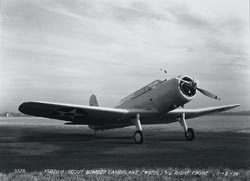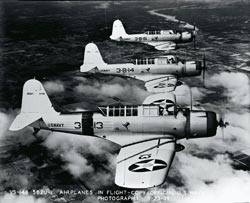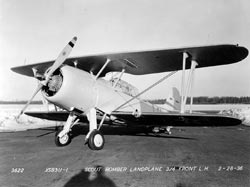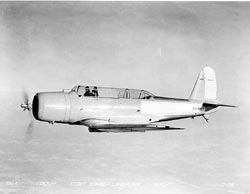|
 The Vought SB2U series of scout/bombers was manufactured between 1936 and 1941 for both the United States Navy and the Marine Corps. When these aircraft were first introduced, they represented a major transition of naval aviation from the biplane to the modern low-wing monoplane. The Vought entry in the Navy Bureau of Aeronautics 1934 design competition featured a number of innovative ideas as well as a number of features carried over from the earlier biplane, SBU-1. The Vought SB2U series of scout/bombers was manufactured between 1936 and 1941 for both the United States Navy and the Marine Corps. When these aircraft were first introduced, they represented a major transition of naval aviation from the biplane to the modern low-wing monoplane. The Vought entry in the Navy Bureau of Aeronautics 1934 design competition featured a number of innovative ideas as well as a number of features carried over from the earlier biplane, SBU-1.
The other entries in the design competition included the Brewster XSBA-1, the Hall XPTBH-1, the Northrop XBT-1 and the Douglas XTBD-1. The Brewster, Northrop and Douglas designs were all-metal monoplanes, while the Hall design was a twin-engine, twin-float seaplane.
 At the same time, the Navy also ordered prototypes of a number of biplane designs in case the monoplane projects failed to meet requirements. All of the biplane designs, except for the XSBC-3 Curtiss biplane, were rejected. At the same time, the Navy also ordered prototypes of a number of biplane designs in case the monoplane projects failed to meet requirements. All of the biplane designs, except for the XSBC-3 Curtiss biplane, were rejected.
An order was placed for 54 SB2U-1 aircraft in October 1936. So while the monoplanes were being developed and introduced into service, biplanes continued to be produced.
 To back up the XSB2U-1 design, Vought also developed a biplane entry, the XSB3U-1. The prototype XSB3U-1 was converted from the last production SBU-1. Except for the prototype’s unique system of landing gear retraction, the XSB3U-1 failed to impress the Navy. The landing gear on the XSB3U-1 retracted backward into the fuselage lower center section and was covered by fairings which were bolted to the landing gear struts. This form of retractable landing gear stowage was far more streamlined than other designs of the time. To back up the XSB2U-1 design, Vought also developed a biplane entry, the XSB3U-1. The prototype XSB3U-1 was converted from the last production SBU-1. Except for the prototype’s unique system of landing gear retraction, the XSB3U-1 failed to impress the Navy. The landing gear on the XSB3U-1 retracted backward into the fuselage lower center section and was covered by fairings which were bolted to the landing gear struts. This form of retractable landing gear stowage was far more streamlined than other designs of the time.
Of the monoplane competitors, the Navy accepted all but the Hall XPTBH-1 for fleet service. The Douglas XTBD-1 became the TBD-1. The Brewster XSBA-1, the only mid-wing monoplane submitted, went into production as the SBN-1. The Northrop XBT-1 had been entered in the competition as a combination dive bomber/scout aircraft and the Navy decided to develop the design as a dive bomber. It was designated as the Douglas SBD Dauntless and became the most widely used dive bomber of World War II.
The XSB2U-1 prototype was a single-engine, two-seat, low-wing, cantilever, and retractable landing gear monoplane that retained the metal and fabric covered fuselage of the earlier Vought aircraft. Most of the tail and wing surfaces were also fabric covered, the wing being almost completely fabric except for a metal leading edge. The wing had a hydraulically operated trailing edge flap installed on the lower wing center section. Additionally, to assist in slowing the aircraft for carrier landings, the ailerons could be drooped to act as auxiliary flaps. It also had foldable wings to decrease space requirements when used aboard carriers. The prototype was powered by a 700-hp Pratt & Whitney R-1535-78 fourteencylinder, air-cooled radial engine driving a two-blade Hamilton Standard constant-speed propeller.
 The aircraft flew for the first time on January 4, 1935 at Rentschler Field, Hartford, Connecticut. After a series of manufacturers’ trials, the aircraft was delivered to the Navy at NAS Anacostia on July 2, 1936. During the Navy tests a number of problems were uncovered. It had been intended to equip the aircraft with a reversible propeller to act as a dive brake; however, this proved to be difficult to use and became technically unsatisfactory. As a replacement, Vought constructed a dive flap that consisted of a number of finger-like spars mounted near the wing leading edge that, during normal flight, were flush with the wing surface but during a dive could be extended at right angles to the wing surface to slow the aircraft. These flaps failed to work satisfactorily because they caused so much drag that full engine power was needed to maintain control. Additionally, the flaps caused severe aileron buffeting, and weighed some 140 pounds. As a result, the Navy decided to adopt a shallower dive angle and to extend the landing gear to act as a form of dive brake. The prototype was also modified to include additional bracing on the pilot’s and observer’s canopies. The aircraft flew for the first time on January 4, 1935 at Rentschler Field, Hartford, Connecticut. After a series of manufacturers’ trials, the aircraft was delivered to the Navy at NAS Anacostia on July 2, 1936. During the Navy tests a number of problems were uncovered. It had been intended to equip the aircraft with a reversible propeller to act as a dive brake; however, this proved to be difficult to use and became technically unsatisfactory. As a replacement, Vought constructed a dive flap that consisted of a number of finger-like spars mounted near the wing leading edge that, during normal flight, were flush with the wing surface but during a dive could be extended at right angles to the wing surface to slow the aircraft. These flaps failed to work satisfactorily because they caused so much drag that full engine power was needed to maintain control. Additionally, the flaps caused severe aileron buffeting, and weighed some 140 pounds. As a result, the Navy decided to adopt a shallower dive angle and to extend the landing gear to act as a form of dive brake. The prototype was also modified to include additional bracing on the pilot’s and observer’s canopies.
SB2U:
Atlantic Operations
Combat at Midway
Phase Out
|